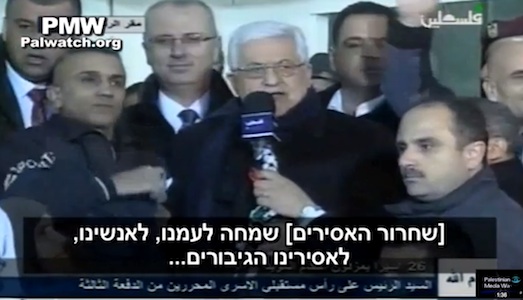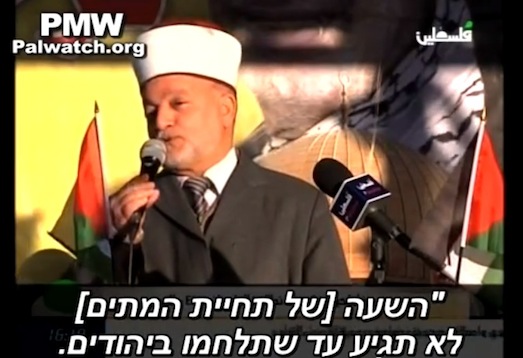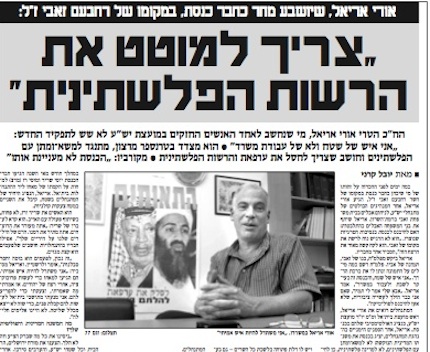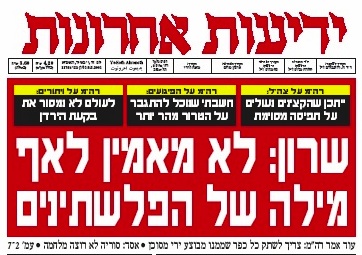It’s not uncommon to hear Israeli leaders accuse the Palestinian Authority and its media outlets of inciting to violence against Israelis and Jews. But is it actually true? A closer examination of the evidence reveals that the habitual blaming of the Palestinian Authority is not only mostly unfounded, it is the product of a direct line between right-wing groups and the Prime Minister’s Office.
By Yizhar Be’er (Translated from Hebrew by Miriam Erez)
John Kerry’s arrival in the region and the looming “threat” of a final-status agreement have compelled right-wing leaders to pull out the old canard of “Palestinian incitement.” So, in a frenzied attempt to keep us all on our toes, the Israeli cabinet dedicated two full hours to the latest strategic “threat” hovering above us, once again calling in the “experts,” with zero advance notice, to present the latest “Palestinian Incitement Index” findings.
Government leaders in Israel habitually blame the Palestinian Authority and its prime minister’s incitement for impeding a peace agreement. “True peace cannot come into being without a halt in incitement against Israel and without education toward peace,” said Netanyahu in a cabinet meeting. Defense Minister Moshe Ya’alon claimed, “The Palestinians still educate toward incitement and bigotry based on quotes from Hitler. They claim that there’s no Jewish people.” Justice Minister Tzipi Livni accepts the served-up-as-truth campaign as unassailable: “The incitement on the Palestinian side is horrible. It’s terrible to educate children to hate,” she said, despite her conclusion that it is precisely because of this that we need a diplomatic solution.

Which sources are fed to Israeli leaders when they accuse the Palestinian Authority of incitement, at a time when security coordination between Israel and the Authority is tighter than it has ever been, and when, in the eyes of many, the PA is lead by the most moderate Palestinian leader there has ever been with whom we can reach a historic compromise? Against this backdrop, the time has come to examine the factual basis upon which rests the incitement crusade against Abbas and the Palestinian Authority.
An extraordinary opportunity to study the issue was laid at the doorstep of the Israeli courts in the form of a series of lawsuits filed against the Palestinian Authority by the families of settlers killed during the Second Intifada. The plaintiffs claimed that incitement in the official Palestinian media led to the murder of their family members.
The plaintiffs based their claims on an official assessment drafted by Palestinian Media Watch (PMW), one of several resource-rich right-wing think tanks that track the Palestinian media as well as remarks made by individual Palestinians, monitoring words of incitement. PMW’s findings are quoted by Israeli officials and are sent to members of Congress. The organization is lead by Itamar Marcus, who lives in the West Bank settlement of Efrat, and who represented Israel in the Wye summit in 1998 on the issue of incitement. Marcus is also a member of the Prime Minister’s Office’s Palestinian Incitement Index Monitoring Committee, whose findings were presented at the most recent Cabinet meeting. Marcus himself writes position papers on incitement for the Prime Minister’s Office and the Foreign Ministry. He also briefs the prime minister, cabinet ministers, advisors, and defense personnel on the subject. In the interest of full disclosure, I was asked to submit a professional assessment for the defense (Yossi Arnon, defense counsel, representing the Palestinian Authority) in the aforementioned trial.
This state of affairs is strange in and of itself: during the course of a violent struggle between two opposing national movements and two opposing narratives, the legal system of one of the sides is asked to hand down a ruling on whether incitement took place on the other side of the barricade; and whether or not this alleged incitement led to the murder of its citizens. In other words, Israeli judges were called upon to rule over whether the Palestinians are guilty, even as the question of the proportional blame of each of the sides for bloodshed was not even addressed.
If so, let us address the first trial and its verdict. This court heard the claim of the family of the late Gilad Zar, who was murdered in Samaria (northern West Bank) during the Second Intifada. The centerpiece of this lawsuit, like others filed in its wake, was incitement. The lawsuit is based on 78 accounts of alleged incitement that Marcus collected over the 14 years from 1995 to 2009, which allegedly prove that the PA and its leaders view the killing of Israeli soldiers, civilians and even children as a national mission, and that it supports and encourages the murder of Jews and Israelis via the media. This period was indeed characterized by bloody clashes between the IDF and Palestinians, wherein thousands were killed and dozens wounded, and emotional temperatures on both sides rose to new heights. Nonetheless, anyone who bothers to glance at the data presented in court cannot fail to raise a skeptical eyebrow in the face of their paucity.
A point-by-point analysis of Marcus’s examples show that nearly half of them are not at all relevant, as they were taken from the Hamas-operated media, Iranian television, or quotes from the press or far-fetched interpretations of innocent remarks.
Incitement and conspiracy theories
Here are some accounts of incitement as submitted to the court: “Allah commanded us in this life to humiliate Jews,” attributed to Sheikh Yusuf Abu Snina on Palestinian TV; a voiceover in a video commemorating Muhammad a-Dura: “He was no different than any other child in the world in terms of his play, his joy, his innocence, his dreams, his laughter, and his tears. All this was cut short by bullets of Zionist hatred.” Another clip shows a child dropping a toy car and in its place, picking up a stone. Voiceover: “We’ll meet one day, Muhammad, child of Palestine” [Palestinian TV, May 2001]. Head of the Fatah’s Shabiba organization in Al-Hiyát el Jdida: “The occupation must pay the price for its aggression against the Palestinian people.” Each of these “accounts” is taken from the beginning of the Second Intifada, and most are based on general terms such as “resistance,” “intifada” and “struggle against the occupation,” which are extrapolated as calls to murder Jews, despite containing no actual calls for violence.

The accounts included a picture in a Palestinian newspaper captioned, “Burning a model of an Israeli bus in a parade in Tulkarem yesterday”; a remark made by an unidentified youth who speaks of his desire to become a shaheed; and a pre-suicide video recorded by a young Hamas member. For the record, the Israeli papers also quote suicide videos when they get a hold of them. Yet another account, published in Al-Hiyát el Jdida, was a report of masked Palestinians carrying Qur’ans in a protest with calls for violence in the background — the event, however, took place in the Ein el-Hilwa refugee camp in Lebanon. Another one of Marcus’ “accounts” is a crossword clue in Al-Hiyát el Jdida whose answer was “Yahya Ayyash” [a Hamas arch-terrorist].
Simple arithmetic shows that in this period, 15,530 newspaper editions were published, each containing dozens of articles. In the same period, Palestine TV and radio aired tens of thousands of broadcast hours, and the PA’s religious and political leaders appeared at thousands of events. The few accounts of incitement represent just a handful of instances – an inconsequential percentage of the entire media discourse in this 14-year period. In any event, only a minority of the Palestinian population is exposed to said incitement.
An analysis of the incitement document submitted to the court shows that 41 accounts were submitted wherein one discerns an alarmist discourse taking place during the most violent years of the relationship between Israel and the Palestinian Authority – the overwhelming majority of which can be categorized as nationalist discourse that presents Palestinian collective narratives, neither calling for nor aimed directly at, murder of Jews.
Based on these few accounts, gathered laboriously and forced into the square hole labeled “incitement,” it is difficult if not impossible to prove the claim in the charge sheet: “There is no doubt that the Palestinian Authority and its leaders viewed the murder of Gilad Zar as carrying out the order to kill.”
Marcus’ is a known method used by right-wing monitoring groups that advise our government: random, non-methodological gathering of accounts over many years, the majority of which are not even attributable to the Palestinian Authority, which our government is currently attempting to depict as a regime of incitement. In these questionably-gathered accounts, no attempt is made to distinguish between statements issued by the official Palestinian Authority media and those of Hamas, who are known for attacking the Palestinian Authority no less rabidly than they attack Israel. Moreover, a misleading mixture was concocted of news content and individuals expressing opinions. The “juiciest” accounts for Middle East news commentators, such as remarks made by a Gaza Sheikh calling the Jews monkeys and pigs, are mainly found in the Hamas-controlled media.
Furthermore, the gatherers of “evidence” of incitement do not bother to employ any accepted fact-checking methods whatsoever, nor do they adhere to even the most basic research protocols. Every media researcher knows the time-tested methods for analyzing media content: qualitative, quantitative, or a combination of the two. Yet the opinion-makers on the subject of Palestinian incitement against Israel make use of none of these. The argument that the Palestinian media, an official organ of the Palestinian Authority, incites against Israelis has never been tested using any valid research tools.
Moreover, a disturbing similarity can be found between right-wing claims of incitement and conspiracy theories. Researchers reject conspiracy theories in the absence of sufficient findings that confirm sightings, or testimonies that contain a kernel of truth to which other items, not supported by facts, are added. Nearly every conspiracy theory confuses hypothesis with proof, i.e., they assume the hypothesis that they try to prove. In most cases, conspiracy theories do not try to raise hypotheses and then prove them, or alternatively, refute them. Rather, they assume – absent any factual support – that their hypotheses are fact.
Another conspicuous characteristic of conspiracy theories and incitement spin is the representation of the enemy as an abstract entity whose members act uniformly and consistently toward a single objective — in our case, killing Jews. If one can state, for example, that all Jews are part of a plot to control the world, or that the U.S. government acts methodically to conceal testimonies of sightings of UFOs, then there is no problem in stating, as per the professional assessment of PA incitement submitted to the court on September 2010, that the PA (via its media outlets), is the responsible, monitoring entity that supports, backs, and encourages terror and suicide attacks. Positing that a symbolic, uniform entity enables conspiracy believers to easily reject every refuting fact or claim.
As per this view, this same symbolic entity (in our case the Palestinian Authority/Palestinian media) is all-powerful, and its activities are characterized by slick efficiency and perfect coordination between all of its organs. Such an entity acts without regard for moral considerations, and without recognition nuances, moral relativity or contradictory arguments.
What gives rise to conspiracy theories is the desire to find a convenient explanation for events or situations for which the existing explanation is felt to be insufficient or uncomfortable. Imagine the effect on many Israelis of the “knowledge” that peace cannot be achieved due to Palestinian incitement, rather than the intransigence of the right in their refusal to give up on their dream of the Greater Land of Israel. Wouldn’t such “knowledge” provide catharsis?
The other side is always to blame
We cannot truthfully state that there haven’t been incidences of defamation and even incitement against Israelis by the Palestinian media and the Palestinian Authority. Of course there have been, just as there has been incitement from our side. By the way, even simple editing, choice of words and camera angles in news coverage are much more efficacious at delegitimizing and dehumanizing than direct, unfiltered incitement, which tends to repel readers and viewers.
Like all nations involved in a long-running conflict, both Israelis and Palestinians employ these devices almost daily. And like any national, ideological conflict, each side in claims history to be on its side, while engaging in violence, killing and human rights violations. The narratives of both sides are to a great extent mirror images of each other, with each side insisting that the responsibility of the for violence, killing, and injustice lies with the other, while minimizing its own responsibility.
In this situation, the media discourse on both sides is the main arena where the contradictory narratives are expressed. The media, particularly during crises, becomes the conduit for trumpeting the justice of each side’s cause, pointing to evidence of the murderous and heinous nature of the opposing side, and even encouraging the use of force with the objective of preserving national pride, strategic deterrence, or negotiating power over the other.
Modern history is rife with examples of both public opinion and the media during national conflicts, which, when they reach crisis mode, tend to circle the wagons, becoming more “patriotic” than in ordinary times. This is done by rationalizing emergency measures in defense and security; wanting to see their side triumph; and encouraging aggression toward the enemy. These can all be observed in Israel during wartime, as they could in the UK during the Falklands crisis of 1982, and in the U.S. at the beginning of the Iraq war in 2003.
Claims of incitement without acknowledging the relativist quality of the two sides’ national narratives cannot be taken seriously without the following: addressing the circumstances of the conflict and its components; attempting to analyze the relative responsibility of each side for the deterioration in relations and escalation of violence; and examining the functioning of the media on both sides.
National narratives are complex, encompassing concepts from the fields of sociology, psychology, philosophy, and communications. In his Archaeology of Knowledge, Michel Foucault insisted on the complexity of the formation of narratives. Discourse is not only language, he claimed, but also a system of structuring reality. In the term “discourse,” Foucault attempted to explain how knowledge is produced, by whom, and in what framework, as well as what interests lie behind its production, and who this knowledge serves. By drawing connections between such concepts as “knowledge” and “truth” in power relations, institutions, and interests, Foucault called into question how we perceive these concepts.
If indeed knowledge and public communications and discourse are, among other things, products of a power struggle between institutions and societies, then our dominance in power over the PA has an apparent unequivocal effect in creating the narrative and myths that claim that the PA is exclusively or mainly responsible for violence, incitement, and the deterioration of the peace process. Such views have evinced sharp criticism both on the parts of former senior defense personnel in Israel, and in studies conducted by Israeli institutions, as we will see below.0
Intelligence experts, among them GSS and IDF Intelligence chiefs, who undergo thorough professional training of the highest quality, are exposed to first-hand intelligence material and know the relevant data backwards and forwards. Their consistent testimonies indicating the absence of factual basis for claiming that the PA is directly responsible for terror and murder speak for themselves. Senior intelligence personnel such as Ami Ayalon, Amos Malka, Mati Steinberg, and Ephraim Lavie have testified to this (and their words have been published elsewhere). In short, the right’s conceptualization of exclusively blaming the other side for incitement, violence, and the absence of a peace agreement is problematic, to say the least.
Scum of the earth
In contrast to the impression one might get from remarks made by members of the Israeli right wing, a reading of the treaties since the Gaza-Jericho agreement – signed as part of the Oslo Accords in 1994 – reveals that the matter of incitement is two-sided. That is to say, Israel officially confirms that it too must address the issue as it pertains to its actions. The interim agreement (Oslo II) stated that there is mutual obligation [my bold] to make efforts to prevent incitement. In the Wye Accords of October 1998, it was agreed to form an Israeli-Palestinian Committee to Prevent Incitement. The committee met for just one year, and until this day has not reconvened.
Abbas claims that it was the Israelis who refused to reconvene the committee. Just recently, Israel refused a Palestinian-U.S. initiative to convene a tri-lateral committee on incitement. The Sharm-a-Sheikh Accords signed by Ehud Barak and Yasir Arafat in 1999 include a clause addressing the “prevention of incitement alongside cooperation between the sides.” The matter of incitement as a two-sided problem also appears in the Bush Road Map of April 2003, the Mitchell Report and in UN Security Council Resolution 1397 (March 2002).
Have words of recrimination and incitement ever been uttered in Israel against the Palestinians? Of course they have. Who cannot recall government spokespeople and news pundits, in a moment of anger, using harsh words about Arabs? Shas leader Ovadia Yosef said the following in 2001: “This is what will happen to the Arabs: their very thinking will be spoiled, they’ll get what they deserve, their seed will be lost, they’ll be destroyed and subdued, and they’ll be lost to the world,”; “The Arabs are crybabies, scum of the earth. Their cries conquer people, they kill. Crocodile tears. Do not show them any mercy!”; “It is forbidden to show them mercy. Send them missiles, go to town. Destroy them, those scum of the earth.” In 2010, Yosef even yearned for Abbas’ death: “Ovadia Yosef wished death upon Palestinian Chair Abu-Mazen and his people, calling them ‘villains, enemies of Israel’.” Former Interior Minister Eli Yishai called for blowing up thousands of [Palestinian] homes and destroying Gaza. In 2002, Knesset Member Ahmed Tibi claimed that as Chief of Staff, Shaul Mofaz was responsible for war crimes after the latter demanded that IDF commanders kill at least sever Palestinians per day during the beginning of the Second Intifada. But of course, the words of sages are uttered quietly, not with raised voices.

Textbook incitement
Alongside claims of incitement by the Palestinian Authority and in the Palestinian media, the Israeli right talks a great deal about incitement against Israel and Jews in Palestinian textbooks. Is there anything to the claim?
Most Israeli and foreign entities that have checked the matter reject the claim. A Knesset Research and Information Center study submitted to the Knesset Education Committee on June 30, 2010, at the request of then-Chairman of the Commission Zvulun Orlev, on how the Jewish people, Israel, Zionism, and peace are presented in Palestinian textbooks, no evidence of direct incitement to violence was found. The report’s conclusions state:
A review of the main reports from recent years of new Palestinian textbooks does not point to an unequivocal picture of direct, overreaching incitement to violence or [to] terror [aimed at] Jews or Israel. At the same time, the studies indicate that in Palestinian textbooks there is an absence of education toward peace…regarding the credibility of studies on Palestinian textbooks conducted by Jewish NGOs, there prevails a certain controversy, some claiming that there are entities ‘walking the thin line between research and politics’…
In addition, there are those who claim that Israeli textbooks do not contribute to advancing the peace process, as they contain expressions of delegitimization of Palestinian nationalism and negative stereotypes of Arabs, among other things, and thus call for a review of their content as well.
The Knesset Research and Information Center report also addressed the findings of previous reports. The 2006 UNESCO report stated: “In none of the reports reviewed [do we find] support for the claim that incitement against Israel or anti-Semitism can be attributed to Palestinian curricula” [p. 11]. The 2002 MEMRI (Middle East Media Research Institute, considered a conservative think tank) report also rejected the claim of direct incitement in Palestinian textbooks:
The new Palestinian textbooks reflect an overall attempt to reduce the venom of the anti-Israeli messages, in contrast to the Egyptian and Jordanian textbooks previously used. Direct incitement in books has decreased, explicit calls for violence are greatly reduced, and efforts have been made to incorporate the values of democracy and liberty.
Three reports compiled on Palestinian textbooks during 2003-2006 by IPCRI (Israel-Palestine Research and Information Center) stated:
Overall, the orientation of the new textbooks is that of peace, despite the difficult and violent reality of Palestinian society and that of the region. The textbooks do not contain direct incitement against Israel or against Jews, nor do they contain direct incitement toward hatred or violence…while the textbooks do not contain direct encourage of hatred and violence, they also do not preach brotherhood and friendship…
On September 9, 2004, Akiva Eldar wrote in Haaretz that the report by the Coordinating Committee in the Territories stated at the beginning of the Second Intifada that in comparison to Egyptian and Jordanian textbooks used in the past, there is improvement in the new Palestinian textbooks, and that “efforts can be discerned on the part of the Palestinians to moderate the sense of enmity toward Israel.”
Only one organization has reached opposite conclusions: Palestinian Media Watch, upon whose findings current government advisors base their comments. For instance, the PMW report of 2007 states:
The textbooks are rife with the terminology of hatred and demonization that reinforce the message that Israel must not be accepted as a neighbor who has the right to exist and with whom it is possible to live in peace…Certainly in the 12th grade textbooks, Israel’s right to exist is rejected…The Israeli-Palestinian conflict is not depicted as a national or territorial one alone, but rather as part of an uncompromising religious struggle of Islam in Israel…It appears that there is an attempt reduce as far as possible addressing topics related to the peace process between Israel and its neighbors and to the Oslo Accords…
The wide gaps between the PMW’s conclusions and those of other reports raise suspicion that its right-wing agenda, as well as that of its director, create distorted perceptions of reality. Unfortunately, these misperceptions are adopted by Israel’s prime ministers.
The court tries to apply interpretation and meaning
On August 28, Tel Aviv District Court Judge Dalia Ganot issued an unprecedented ruling completely rejecting Marcus’s assessment that PA incitement led to the murder of Gilad Zar. From her ruling:
This question was not examined by the expert Marcus, who does not distinguish between his assessment and news media content, or expression of opinion, or broadcasts on social issues…and in any case [he] did not attempt to estimate the time frame of issued remarks of incitement proportionate to total broadcast times, and therefore, the expert Be’er’s [the author] statement is correct in its clarity:
The matter of the assessment submitted by the plaintiffs in the name of Mr. Itamar Marcus, is an attempt to interpret and attach meaning to selected content sampled randomly from the entire discourse occurring in the Palestinian Authority during the clashes and the Second Intifada…taking into account the absence of any accepted valid testing method, that could serve as a foundation for some sort of suit, his assessment is [hereby] rejected…
Marcus did not elucidate in his assessment the body of knowledge that he studied, how many texts were included therein, and what the proportions were between the level of texts that prove his claim of incitement, and the quantity of texts that reject it, and I hereby accept these remarks in the language in which they are written, and as aforementioned, the conclusion is that the plaintiffs did not bear the burden of proof imposed upon them, and did not prove their claim.”
The court’s verdict dismantled the foundation upon which rest the Israeli right’s claims of Palestinian incitement. And while the first lawsuit was unsuccessful, there are at least seven similar suits are being tried currently, all based on assessments by the same source: Ittamar Marcus and PMW.
Judge Ganot’s verdict will likely not change much beyond having saved the Palestinian Authority the heavy costs of victim compensation, just as the French court’s verdict that the photos of the late Muhammad a-Dura were authentic, will not change the belief of many that a-Dura is alive and well and residing in Gaza. After all, our present leadership believes – or so it would seem – that there is a need to find a convenient explanation for the uncomfortable reality that makes so many squirm. And what’s more convenient for an Israeli citizen than the “knowledge” that peace is unattainable due to Palestinian incitement, and not to the right’s intransigence? What a catharsis, right?
Read more:
Judge dismisses credibility of Palestinian Media Watch testimony
Hamas textbook incitement and Israeli manipulation
Yizhar Be’er is a former journalist who serves as director of Keshev, which monitors Israeli media coverage. This post originally appeared in Hebrew on Haokets.


